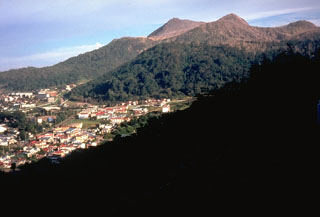Report on Toya (Japan) — September 1977
Natural Science Event Bulletin, vol. 2, no. 9 (September 1977)
Managing Editor: David Squires.
Toya (Japan) Cryptodome rises to 70 m by late September
Please cite this report as:
Global Volcanism Program, 1977. Report on Toya (Japan) (Squires, D., ed.). Natural Science Event Bulletin, 2:9. Smithsonian Institution. https://doi.org/10.5479/si.GVP.NSEB197709-285030
Toya
Japan
42.544°N, 140.839°E; summit elev. 733 m
All times are local (unless otherwise noted)
No explosions have been reported since 14 August, but a new cryptodome at the E foot of Ko-Usu, surrounded by a 1.5-km semicircular fissure zone, had risen about 70 m by late September. Local earthquake swarms continued.
Geological Summary. Usuzan, one of Hokkaido's most well-known volcanoes, is a small stratovolcano located astride the southern topographic rim of the 110,000-year-old Toya caldera. The center of the 10-km-wide, lake-filled caldera contains Nakajima, a group of forested Pleistocene andesitic lava domes. The summit of the basaltic-to-andesitic edifice of Usu is cut by a somma formed about 20-30,000 years ago when collapse of the volcano produced a debris avalanche that reached the sea. Dacitic domes erupted along two NW-SE-trending lines fill and flank the summit caldera. Three of these domes, O-Usu, Ko-Usu and Showashinzan, along with seven crypto-domes, were erupted during historical time. The 1663 eruption of Usu was one of the largest in Hokkaido during historical time. The war-time growth of Showashinzan from 1943-45 was painstakingly documented by the local postmaster, who created the first detailed record of growth of a lava dome.
Information Contacts: Y. Katsui, Hokkaido Univ.; JMA, Tokyo; L. Siebert, SI; Asahi Evening News.

